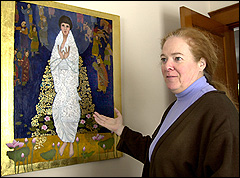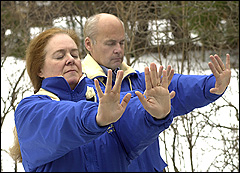MaineToday.com & Portland Press Herald: The art of protest
Sunday, February 20, 2005
|
|||
 |
|
||
|
|
||
Gale and his wife Mary Byrom, a visual artist, are following a long tradition of using their creative talents to bring the world's attention to a cause.
Through their art and music, they are portraying the persecution of people who practice Falun Gong, a form of meditative exercise used for fitness, healing and personal growth.
The couple has traveled to New York, Washington, D.C., Chicago and Boston to give concerts, participate in art exhibits, and develop living theater exhibitions that depict the Chinese government's treatment of Falun Gong practitioners.
Falun Gong - also known as Falun Dafa - is related to qigong and tai chi and has philosophical roots in Buddhism and Daoism. Its three principles are truthfulness, compassion and forbearance.
"We try to keep those principles first and foremost in our daily lives, and in our thinking and in our action," said Gale, who has been practicing Falun Gong since 1998.
"That's why this practice became so powerful and so popular in China. Not only did it make people feel better physically, but it made them feel better in their daily lives."
China outlawed Falun Gong in 1999 and began systematically arresting, harassing and abusing those who continued to practice it. Some people were sent to labor camps; others just disappeared.
Followers in the United States and elsewhere have been holding nonviolent protests ever since, trying to get the rest of the world to pay attention.
In 2003, the Maine Legislature passed a joint resolution in support of Falun Gong and condemning the Chinese government's crackdown on the movement. Similarly, the U.S. House and Senate each passed resolutions calling on China to stop its human rights abuses against Falun Gong practitioners. "The next front is corporate America, who obviously is dealing with China and tends to look the other way in these kinds of human-rights things," Gale said.
Gale went to college in the late 1960s and, like a lot of young people at the time, dabbled in yoga and other spiritual traditions. He also got into music and theater before laying down his guitar for 10 years.
When he picked up the instrument again, he started taking it to day-care centers and preschools to play for kids and participate in their music programs. By 1994, he was writing children's songs and performing full-time. Gale, 53, has recorded two children's music CDs and plays at fairs and festivals around the state, incorporating storytelling and puppetry into his performances.
If not for Falun Gong, his musical portfolio might not have gone much further than his popular recordings, "Sing Along, Laugh Along" and "So Glad!"
A LIFE-CHANGING DECISION In 1997, Gale saw a flyer in a bookstore offering free Falun Gong classes. By May 1998, he was learning the practice from a Chinese couple.
"He started it, and he looked so fabulous," Byrom said. "All my friends were talking about it: 'Marcus looks really healthy.' "
By July, Byrom and her friends had signed up for classes, too. Byrom, 52, says the practice has radically changed both her consciousness and the style of her work.
"I became less selfish," Byrom said. "Now I'm actually thinking of someone else, a larger group of people."
Byrom was an abstract painter who, before getting involved in Falun Gong, had never used her art "for anything except the pure act of art."
"I was very focused on being an artist, and it was very private," she said.
The last abstract painting she did is a splash of copper hues, blues, greens and layers of bright gold leaf. But as Byrom practiced Falun Gong, she started to move toward realism.
"I started to see visually," she recalled. "I would actually get visuals of things I wanted to paint that had nothing to do with abstraction."
In her studio next to the house, Byrom now works on landscapes. Studies done during trips to the Rachel Carson National Wildlife Refuge are scattered throughout the room, as she works on her skills painting images and using light and color in a different way.
She is also painting figures and portraits.
"If you can paint a human being, you can paint anything," Byrom said. "I decided that I was going to learn how to do it and become good at it. It's taken me to this whole other realm."
Her first Falun Gong work is based on a Gustav Klimt portrait. Titled "The End of the Dharma-Ending Period," it depicts a Western Falun Gong practitioner instead of the "haughty society woman" in the Klimt work, Byrom said.
The white dress is the same, but in Byrom's painting the woman's demeanor is kind. She is gesturing with her hands, a pose known as the lotus palm.
"By doing this, she is literally clearing out all the evil in the universe," Byrom said. "She's purifying the Earth."
Behind her are Chinese figures who represent the past. In front of her, the gold of her energy field is being transformed into pink lotus blossoms.
"The lotus blossoms are breaking through the outside boundary beyond the painting because the future is transformation," Byrom said.
Gale's creative contribution to the Falun Gong cause has been two original songs, "The Trial" and "The World Knows the Truth."
He is recording a third song, "Why?" which focuses on the plight of the orphaned children of Falun Gong.
"The Trial" is a commentary on the 16 civil lawsuits that have been filed worldwide against Jiang Zemin, the Chinese leader who outlawed Falun Gong. "The World Knows the Truth" is an indictment of what Gale believes are numerous wrongs committed by the government, from the Tiananmen Square shootings to the repression of Falun Gong:
You poison your country, against Falun Gong You torture and kill them; the world knows it's wrong. The world will seek justice and stand up for truth China is lying, and now there is proof. Chorus: Your people are dying, China stop lying Why do you lie, when your own people die? The world is crying, good people dying So many lies, the whole world cries.
The songs have been played all over the world on a Falun Gong Internet radio station, Sound of Hope, which is something like Voice of America, Gale said. He has also been invited to perform them all over the country.
In 2003, UNESCO and the Comparative Human Rights Department at the University of Connecticut invited Gale to participate in an international conference called "Artists in the Cause of Human Rights."
BECOMING MORE INVOLVED
In May 2004, Gale was invited to Chicago to perform "The Trial." The occasion was a federal court appeal in one of the civil lawsuits against Jiang Zemin.
While Gale and Byrom were there, the organizers asked Byrom if she would help with some of the living-theater displays that were being used in the protest. Byrom worked in theater and costume design in the 1980s in New York City, so she went into the project with some experience.
Upon her return home, she got a phone call asking if she would design and coordinate 12 similar exhibits for the Democratic National Convention. The performances would run 10 hours a day for six days.
"I had to study all the different types of torture, and then I had to design ones that would fit in a really small space and visually would be completely arresting to passers-by," she said.
Three thousand people came from all over the world to take shifts as actors in the tableaus.
She did a similar exhibit in New York for the Republican convention - one that is still going on today. Volunteers fly in from all over the world to take part, Byrom said. The project was the subject of a New York Times story in September.
Each scene is done in black-and-white. The only color is the blood and bruises on the victims.
One scene, for example, depicts a woman in white sitting in a small cage, with some strategically-placed "blood" on her clothes and a bruise on her cheek. A policeman dressed in a black uniform - the police always wear black - stands behind her with his billy club raised. Behind them both is a banner that says "This is happening in China."
Byrom had to balance the graphic nature of the subject with the importance of getting her message across.
"There's something that happens as you look at one," Byrom said. "They are very, very powerful."
In December, Byrom was the curator of a Boston exhibit of paintings, sculptures and etchings by international artists who practice Falun Gong. She is now developing a series of forums for colleges and universities to discuss human-rights violations committed over the years by the Chinese Communist Party.
Byrom and Gale hope their efforts will open some eyes and perhaps make some businesses and organizations think twice before doing business with China.
"I think the real purpose is to educate people and let people make their own decisions," Byrom said. "I'm not ever going to say, 'Don't do business with China.' I'm going to say, 'Please know what's really going on here, and then you make your choice.' "
http://entertainment.mainetoday.com/art/050220protest.shtml
